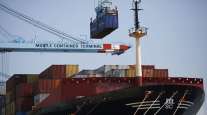Intermodal Leaders See Growth Opportunities In Mexico, the East and Refrigerated Freight
This story appears in the Nov. 25 print edition of Transport Topics.
HOUSTON — Intermodal transportation continues to see growth opportunities in Mexico, the eastern region of the United States, temperature-controlled service and partnerships with brokers.
That was the broad near-term consensus from nearly a dozen speakers addressing a joint meeting of the Intermodal Association of North America, Transportation Intermediaries Association and the National Industrial Transportation League here last week.
They offered their assessments as truck-rail shipments are on course to set volume records in the United States and Mexico with an anticipated 4% increase.
“A real good-news story is Mexico,” said Kari Kirchhoefer, assistant vice president of Union Pacific’s Streamline unit. The railroad is targeting more than 2 million loads moving annually over the highway between the United States and Mexico.
The railroad is expanding cross-border service by offering an all-rail intermodal service into and out of Monterrey over two routings. It’s also targeted growth in refrigerated, tank, bulk and flatbed intermodal.
“There is an awful lot of growth opportunity for intermodal,” said Jim Filter, senior vice president of intermodal commercial management for Schneider National, even for a carrier that currently gets 30% of its annual revenue from intermodal. Like others, Filter cited the East and Mexico as important opportunities.
He noted that just 15% of loads that could move by truck-rail combination are doing so now in the East, and just 5% are going intermodal to and from Mexico.
In the East, CSX is adding terminals in Florida and Montreal, while Norfolk Southern expands in Pennsylvania, North Carolina and New York.
Sam Niness, assistant vice president for Norfolk Southern’s Thoroughbred Direct Intermodal Services, and Chip Smith, chief operating officer for Bay & Bay Transportation, based in Rosemount, Minn., said interest in temperature-controlled service through intermodal is rising.
Smith, who describes his company as “mode agnostic,” said intermodal is no longer limited to specific routes; it is being evaluated more intensely by customers who are seeing tight truck capacity and as a temperature-controlled service alternative.
Niness said brokers continue to be the fastest-growing users of intermodal and that half of the intermediaries are inquiring about rail for refrigerated freight.
“The railroads feel refrigerated business is the final frontier,” said Jeff Brashares, a senior vice president for freight broker TTS.
The latest competitor in the refrigerated area is Tiger Cool Express, which plans to begin service in February, carrying fresh produce from California, Texas and Florida to the eastern United States and Canada. The new service was announced earlier this month.
Shippers also expect more growth.
“There is room for growth in intermodal,” said Kevin Santori, manager of truckload and intermodal operations for Shaw Industries, a floor products manufacturer, which already moves about 10% of volume by intermodal. “Fortunately, we don’t have to introduce truck very often” to replace delayed trains, he added.
Not all future intermodal growth was tied to new markets. Avondale Partners analyst Donald Broughton said future opportunities for intermodal are directly tied to diesel prices, which can determine whether shipments move over the road or by rail.
As the price of diesel rises, so does intermodal traffic on shorter-haul routes, Broughton explained, because fuel costs eat up a higher percentage of expenses on shorter-haul truck runs than they do for a transcontinental move.
Broughton noted a strong long-term correlation between diesel prices and domestic intermodal growth, which has been above 10% this year on routes linking the Midwest and Southeast, and within the Southeast. “If I was going to convert [from truck to intermodal] from L.A. to Chicago, I probably would have done it when diesel was $1.75 a gallon,” he said.
“There was no reason to convert Chicago-to-Atlanta moves when diesel was at $1.75,” he added, “but there is now,” when diesel costs $2 more per gallon.
Industry financial consultant Tony Hatch said intermodal also could gain business from private fleets, adding that constraints from truck productivity and driver shortages also will power future intermodal growth.
“We are seeing a period where players are positioning their chips where growth will be,” Hatch said, referring to railroads’ growing investment in intermodal as coal and other businesses flounder.




